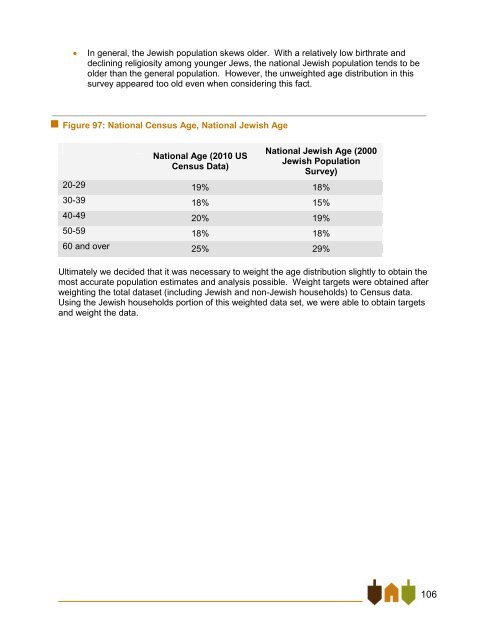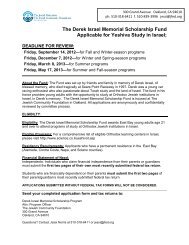East Bay Jewish Community Study - Jewish Federation of the ...
East Bay Jewish Community Study - Jewish Federation of the ...
East Bay Jewish Community Study - Jewish Federation of the ...
Create successful ePaper yourself
Turn your PDF publications into a flip-book with our unique Google optimized e-Paper software.
In general, <strong>the</strong> <strong>Jewish</strong> population skews older. With a relatively low birthrate and<br />
declining religiosity among younger Jews, <strong>the</strong> national <strong>Jewish</strong> population tends to be<br />
older than <strong>the</strong> general population. However, <strong>the</strong> unweighted age distribution in this<br />
survey appeared too old even when considering this fact.<br />
Figure 97: National Census Age, National <strong>Jewish</strong> Age<br />
National Age (2010 US<br />
Census Data)<br />
National <strong>Jewish</strong> Age (2000<br />
<strong>Jewish</strong> Population<br />
Survey)<br />
20-29 19% 18%<br />
30-39 18% 15%<br />
40-49 20% 19%<br />
50-59 18% 18%<br />
60 and over 25% 29%<br />
Ultimately we decided that it was necessary to weight <strong>the</strong> age distribution slightly to obtain <strong>the</strong><br />
most accurate population estimates and analysis possible. Weight targets were obtained after<br />
weighting <strong>the</strong> total dataset (including <strong>Jewish</strong> and non-<strong>Jewish</strong> households) to Census data.<br />
Using <strong>the</strong> <strong>Jewish</strong> households portion <strong>of</strong> this weighted data set, we were able to obtain targets<br />
and weight <strong>the</strong> data.<br />
106




